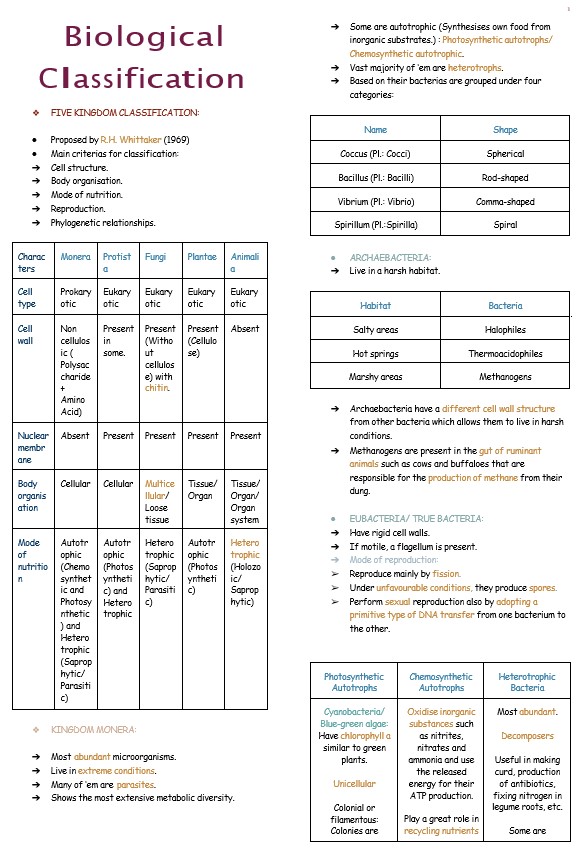Biological Classification
Summary:
The Five Kingdom Classification was proposed by R.H. Whittaker in 1969 and is based on cell structure, body organization, mode of nutrition, reproduction, and phylogenetic relationships. The five kingdoms are Monera, Protista, Fungi, Plantae, and Animalia.
Monera comprises prokaryotic cells and includes archaebacteria and eubacteria. They are abundant microorganisms, living in extreme conditions and exhibiting metabolic diversity.
Protista consists of single-celled eukaryotes, primarily aquatic, and forms a link with other kingdoms. They include chrysophytes, dinoflagellates, euglenoids, slime molds, and protozoans.
Fungi are heterotrophic organisms, decomposing organic matter or acting as parasites. They have filamentous bodies called hyphae, which form a network called mycelium. Fungi reproduce both asexually and sexually.
Plantae are multicellular organisms with cell walls made of cellulose. They are autotrophic, meaning they can produce their own food through photosynthesis.
Animalia are multicellular, eukaryotic organisms without cell walls. They are heterotrophic, obtaining nutrition from other organisms.
Viruses, viroids, prions, and lichens are not part of the Five Kingdom Classification. Viruses are non-cellular infectious agents with protein coats, while viroids are infectious RNA molecules without protein coats. Prions are infectious proteins, and lichens are symbiotic associations between algae and fungi.
Excerpt:
Biological Classification
❖ FIVE KINGDOM CLASSIFICATION:
● Proposed by R.H. Whittaker (1969)
● Main criterias for classification:
➔ Cell structure.
➔ Body organisation.
➔ Mode of nutrition.
➔ Reproduction.
➔ Phylogenetic relationships.
| Charac ters | Monera | Protist a | Fungi | Plantae | Animali a |
| Cell type | Prokary otic | Eukary otic | Eukary otic | Eukary otic | Eukary otic |
| Cell wall | Non cellulos ic ( Polysac charide
+ Amino Acid) |
Present in some. | Present (Witho ut cellulos
e) with chitin. |
Present (Cellulo se) | Absent |
| Nuclear membr ane | Absent | Present | Present | Present | Present |
| Body organis ation | Cellular | Cellular | Multice llular/ Loose tissue | Tissue/ Organ | Tissue/ Organ/ Organ system |
| Mode of nutritio n | Autotr ophic (Chemo synthet ic and Photosy nthetic
) and Hetero trophic (Saprop hytic/ Parasiti c) |
Autotr ophic (Photos yntheti
c) and Hetero trophic |
Hetero trophic (Saprop hytic/ Parasiti c) | Autotr ophic (Photos yntheti c) | Hetero trophic (Holozo ic/ Saprop hytic) |
❖ KINGDOM MONERA:
➔ Most abundant microorganisms.
➔ Live in extreme conditions.
➔ Many of ‘em are parasites.
➔ Shows the most extensive metabolic diversity.


Reviews